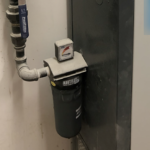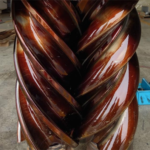
Despite years of warnings — and the development of OSHA standards — there are still many dangerous compressed air blow wands in service at facilities throughout the world.
Countless injuries and even deaths could have been prevented if safer devices were used or the blowing eliminated altogether.
Fig. 1 shows a wand used to clean the coolers of an air compressor, discovered this year. It has an open end that will develop hazardous pressures if pressed against the skin can develop embolisms.
The wand is unguarded and can allow sharp debris to blow back and injure the operator. And the want is uncontrolled, if accidentally dropped the tip with flail around, becoming a dangerous projectile.
A better solution for any and all blowing is the use of safety style nozzles that limit the tip pressure to no more than 30 psi. Most optimized nozzles also limit the sound pollution caused by the escaping compressed air, improving the work environment.





Leave a Reply